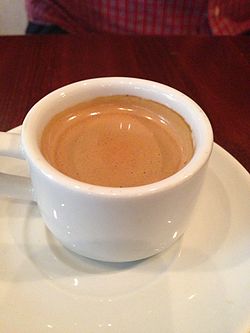Cuban espresso, also known as Café Cubano (or Colada, Cuban coffee, cafecito, Cuban pull, and Cuban shot), is a type of espresso that originated in Cuba. Specifically, it refers to an espresso shot which is sweetened (traditionally with natural brown sugar whipped with the first and strongest drops of espresso).[1] However, the name can refer to coffee based drinks that include Cuban espresso as the main ingredient, such as café con leche.
 | |
| Alternative names | Cuban coffee, cafecito, Cuban pull, Cuban shot |
|---|---|
| Type | Beverage |
| Place of origin | Cuba |
| Main ingredients | espresso, demerara sugar |
Drinking café cubano remains a prominent social and cultural activity in Cuba and in Cuban-American communities, particularly in Miami, Tampa and the Florida Keys.[2][3][4]
Preparation
editTraditional Cuban-style coffee is made using the darker roasts, typically either Italian or Spanish roasts, with the brands Café Bustelo, Café La Llave and Café Pilón being popular. It can be made using an electric espresso machine, but is commonly made with a moka pot.[1][5]
A small portion of espresso from early in the brewing is added to sugar and vigorously mixed with a spoon into a creamy foam called espuma or espumita.[6][7][8] The heat from the coffee making process will hydrolyze some of the sucrose, thereby creating a sweeter and slightly more viscous result than a normal pull or adding sugar at the table.[9]
Serving
editIn addition to being served at Cuban restaurants, in areas with a high Cuban population, small cafés (or parts of larger establishments) will have small windows, or ventanitas, where Cuban coffee can be ordered. Cuban coffee is often bought with tostada (a buttered slice of Cuban bread), pastelitos, or other Cuban pastries.[10]
Variations
editCortadito is a standard espresso shot topped off with steamed milk. The ratio can be between 50/50 and 75/25 espresso and milk. It is similar to a cortado served in other Latin countries, but pre-sweetened.[11][12][13]
Café con leche, or "coffee with milk", is an espresso served alongside a cup of hot or steamed milk. Traditionally served separate from the coffee, the espresso is poured to the desired darkness into the cup of hot milk and then stirred. It is the traditional Cuban breakfast beverage, served with slices of buttered, toasted cuban bread.[14][15][13]
Colada is 3–6 shots of Cuban-style espresso served in a Styrofoam cup along with small, plastic demitasses. It is a takeaway form, meant to be drunk as one shot. This is customary of workplace breaks in Cuban communities.[16][17]
See also
editReferences
edit- ^ a b "How to Make Cuban Coffee - Cafe Cubano Recipe | MokaBees". MokaBees • Coffee Recipes & How-Tos. 19 June 2015. Archived from the original on 7 February 2019. Retrieved 6 February 2019.
- ^ Lisa Simundson (2001). Miami and the Florida Keys. Hunter Publishing, Inc. pp. 24–. ISBN 978-1-55650-913-1.
- ^ Bob Brooke (1 September 2007). The Everything Family Guide to Coastal Florida: St. Augustine, Miami, the Keys, Panama City—and All the Hot Spots in Between!. Adams Media. pp. 104–. ISBN 978-1-60550-239-7.
- ^ Sarah Hull; Stephen Keeling (11 October 2012). The Rough Guide to Florida. Rough Guides. pp. 63–. ISBN 978-1-4093-5999-9.
- ^ Lindgren, Glenn M. (2004). Three guys from Miami cook Cuban. Gibbs Smith, publisher. p. 2. ISBN 158685433X. OCLC 54677627.
- ^ Ana Sofia Pelaez (28 October 2014). The Cuban Table: A Celebration of Food, Flavors, and History. St. Martin's Press. pp. 45–. ISBN 978-1-4668-5753-7.
- ^ Steven Otfinoski (September 2009). 1990S To 2010. Marshall Cavendish. pp. 21–. ISBN 978-0-7614-4625-5.
- ^ Restaurant Business. Restaurant Business. October 1999.
- ^ "Espresso versus Cuban Coffee". J. Martinez & Company - Coffee Merchants. 24 April 2012. Archived from the original on 22 October 2017. Retrieved 20 May 2016.
- ^ Campbell, Geraldine (17 December 2019). "A Guide to Ordering & Drinking Cuban Coffee". The Kitchn. Retrieved 27 May 2023.
- ^ Susan Zimmer (25 February 2014). I Love Coffee!: Over 100 Easy and Delicious Coffee Drinks. Andrews McMeel Publishing, LLC. pp. 213–. ISBN 978-1-4494-6011-2.
- ^ Ted Henken (29 October 2013). Cuba. ABC-CLIO. pp. 372–. ISBN 978-1-61069-012-6.
- ^ a b Ana Quincoces Rodriguez (23 October 2012). Sabor!: A Passion for Cuban Cuisine. Running Press. pp. 326–. ISBN 978-0-7624-4889-0.
- ^ Daniel Young (11 March 2009). Coffee Love: 50 Ways to Drink Your Java. John Wiley & Sons. pp. 51–. ISBN 978-0-470-28937-2.
- ^ Victoria Shearer (20 November 2012). Florida Keys Cookbook: Recipes & Foodways of Paradise. Globe Pequot Press. pp. 271–. ISBN 978-0-7627-9084-5.
- ^ Steven Raichlen (11 January 1993). Miami Spice: The New Florida Cuisine. Workman Publishing Company. pp. 16–. ISBN 978-0-7611-6439-5.
- ^ Jose Garces (19 November 2013). The Latin Road Home: Savoring the Foods of Ecuador, Spain, Cuba, Mexico, and Peru. Lake Isle Press. pp. 322–. ISBN 978-1-62921-343-9.[permanent dead link]